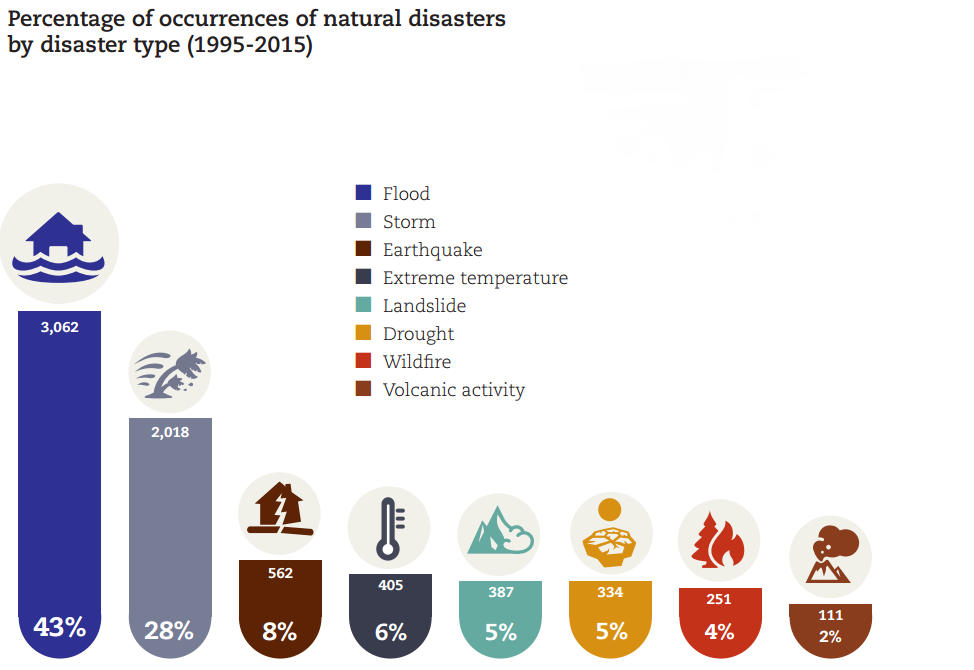Which countries were hit by the most natural disasters in 2015?

A girl walks over some rocks after heavy rain. Image: REUTERS/Muhammad Hamed

Get involved with our crowdsourced digital platform to deliver impact at scale
Stay up to date:
Future of the Environment
Weather and climate extremes were a factor in more than 90 percent of natural disasters in 2015, new figures from an international disaster database show.
In the hottest year on record, with temperatures pushed up by global warming and a strong El Niño weather phenomenon, 32 major droughts were recorded.
That was more than double the 10-year annual average from 2005 to 2014, according to the Belgium-based Centre for Research on the Epidemiology of Disasters (CRED).

Source UN
"The main message from this trends analysis is that reducing greenhouse gases and adapting to climate change is vital for countries seeking to reduce disaster risk now and in the future," said Robert Glasser, head of the U.N. Office for Disaster Risk Reduction (UNISDR).
Here are some facts and figures on natural disasters in 2015:
* The death toll from 346 major reported disasters last year was 22,773, including 8,831 deaths caused by an earthquake in Nepal in April. Overall, disaster deaths were considerably down on the 10-year average of 76,424 deaths.
* The Nepal disaster confirmed that quakes are the most deadly natural hazard category, highlighting the importance of ensuring compliance with building codes, the UNISDR said.
* The top five most disaster-hit countries in 2015 were China (26 disasters), the United States (22), India (19), the Philippines (15) and Indonesia (11).
* Droughts affected 50.5 million people in 2015, well above the 10-year average of 35.4 million. Many of the droughts have continued into 2016, particularly in Africa, the UNISDR noted.
* Floods have traditionally affected the most people in any given year, but were in second place in 2015, with 152 floods affecting 27.5 million people and claiming 3,310 lives.
* The UNISDR said national disaster management agencies in Asia have done well in reducing death tolls from storms through early warnings and timely evacuations, especially in the Philippines, China, Japan and Pacific small island states.
* 996 fatalities were recorded in a total of 90 storms last year, compared to an annual average death toll of 17,778 from 2005 to 2014.
* Record global temperatures in 2015 contributed to a major loss of life from heatwaves, including a total of 7,346 deaths, mainly in France, India and Pakistan. Mortality from extreme temperatures is underestimated and better evaluation of their impact is needed, CRED said. Sources: Centre for Research on the Epidemiology of Disasters (EM-DAT database - http://www.emdat.be/database) and U.N. Office for Disaster Risk Reduction (UNISDR) (Reporting by Megan Rowling; editing by Ros Russell. Please credit the Thomson Reuters Foundation, the charitable arm of Thomson Reuters, that covers humanitarian news, women's rights, trafficking, corruption and climate change. Visit http://news.trust.org)
Don't miss any update on this topic
Create a free account and access your personalized content collection with our latest publications and analyses.
License and Republishing
World Economic Forum articles may be republished in accordance with the Creative Commons Attribution-NonCommercial-NoDerivatives 4.0 International Public License, and in accordance with our Terms of Use.
The views expressed in this article are those of the author alone and not the World Economic Forum.
The Agenda Weekly
A weekly update of the most important issues driving the global agenda
You can unsubscribe at any time using the link in our emails. For more details, review our privacy policy.
More on Nature and BiodiversitySee all
Naoko Tochibayashi and Mizuho Ota
September 18, 2024
Naoko Tochibayashi and Mizuho Ota
September 18, 2024
Simon Torkington
September 3, 2024
Joe Myers and Madeleine North
September 3, 2024
Pavitra Raja and Jack Hurd
August 27, 2024





